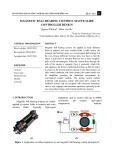
ISSN: 2615-9740
JOURNAL OF TECHNICAL EDUCATION SCIENCE
Ho Chi Minh City University of Technology and Education
Website: https://jte.edu.vn
Email: jte@hcmute.edu.vn
JTE, Volume 20, Issue 01, 02/2025
21
Determining the Optimum Location for Charging Stations Based on Voltage
Stability in the Microgrid
Ngoc Thuong Huynh Thi1*, Trieu Tan Phung2, Trong Nghia Le1, Huy Anh Quyen1,
Duy Anh Ta2, Tung Giang Tran 1
1Ho Chi Minh City University of Technology and Education, Vietnam
2Cao Thang Technical College, Ho Chi Minh City, Vietnam
*Corresponding author. Email: thuonghtn@hcmute.edu.vn
ARTICLE INFO
ABSTRACT
Received:
04/04/2024
The paper presents the investigation into determining suitable locations for
electric vehicle charging stations within the Microgrid 16-Bus system
based on the objective of considering voltage stability using the FVSI and
RVS indices. This study examines the impact of charging stations on the
electrical grid at each bus during charging power mode by evaluating the
FVSI and RVS parameters of the Microgrid when varying charging power
respectively at each bus. Consequently, this research draws conclusions
regarding optimal charging station placements or recommendations for
locations where charging stations should not be placed. Simulation results
demonstrate the effectiveness of voltage stability indices in identifying
nodes with significant voltage loss. Hence, identifying buses to avoid
installing charging stations and determining stable buses where charging
stations can be installed. Specifically, the system frequency only recovers
with charging levels below 50%. Bus 5 is identified as advantageous in
terms of voltage, with the lowest FVSI of 0.185 among load buses. The
simulation process and testing the effectiveness of the proposed method are
evaluated using PowerWorld software. Simulation results demonstrate that
the proposed locations provide voltage stability. The voltage drop at Bus 5
is only 1.52%, which is 5% lower than the normal allowable value of
national power grids.
Revised:
26/04/2024
Accepted:
03/05/2024
Published:
28/02/2025
KEYWORDS
Electrical Vehicle Charging Station
(EVCS);
Electrical Vehicle (EV);
Fast Voltage Stability Index (FVSI);
Reciprocal Voltage Sensitivity (RVS);
Voltage Stabilization.
Doi: https://doi.org/10.54644/jte.2025.1567
Copyright © JTE. This is an open access article distributed under the terms and conditions of the Creative Commons Attribution-NonCommercial 4.0
International License which permits unrestricted use, distribution, and reproduction in any medium for non-commercial purpose, provided the original work is
properly cited.
1. Introduction
The integration of solar energy systems and electric vehicle (EV) charging stations can enhance
effectively the on-site renewable energy consumption and reduce indirectly the carbon emissions of EV
users. Today, the rapid development of electric vehicle systems, especially electric cars, has driven the
construction of charging stations. The challenge lies in economically and technically rational placement
of these stations, a concern shared by many researchers. The cost and operating range of electric vehicles
can only be optimally addressed when a well-developed charging infrastructure is in place.
The essential task is to ensure that charging stations satisfy economic, technical, and minimal grid
impact criteria. Research [1] presents a model for selecting the location of solar-powered charging
stations combined with a Geographic Information Systems (GIS). Multi-criteria decision-making
methods are applied in this case, utilizing the AHP and FUZZY AHP algorithms. This paper
demonstrates rational placement of solar-powered charging stations. In the AHP method employed by
this paper, criteria include: firstly, natural conditions (population density, average annual environmental
temperature); secondly, economic conditions (construction costs and payback period); thirdly, technical
factors (impact on the grid and future scalability); fourthly, social factors including government
recognition and community acceptance.
Similarly, Dogus Guler & Tahsin Yomralioglu [2] proposed a solution to determine charging station
locations based on the integration of GIS and Analytical Hierarchy Process (AHP) and fuzzy AHP
algorithms. In this study, the authors used three criteria of the AHP method to determine charging station
locations: accessibility, environmental, and economic factors.

ISSN: 2615-9740
JOURNAL OF TECHNICAL EDUCATION SCIENCE
Ho Chi Minh City University of Technology and Education
Website: https://jte.edu.vn
Email: jte@hcmute.edu.vn
JTE, Volume 20, Issue 01, 02/2025
22
Figure 1 provides an overview of the criteria considered within the three categories. Specifically, for
the convenience criterion, it includes Income rates, Transportation stations, Petrol stations,...; for the
environmental aspect, only Green areas are considered; and finally, for the economic criterion, it
involves slope and land values.
Figure 1. Application of AHP integrating geographic information system (GIS) to determine charging station
location.
In addition, the authors also utilized ten criteria, including population density, park areas, shopping
malls, roads, green areas, income rates, slope, transportation stations, land values, and petrol stations,
when applying the Fuzzy AHP algorithm to determine charging station locations, as depicted in Figure
2 as follows:
Figure 2. Applying FAHP to locate charging stations in the power grid.
Ali Karas¸an and colleagues [3] proposed a decision-making process for selecting charging station
locations based on fuzzy sets. The study applied fuzzy sets utilizing AHP, TOPSIS, DEMATEL to
evaluate criteria including cost, geographic location, reliability and safety, and social factors to

ISSN: 2615-9740
JOURNAL OF TECHNICAL EDUCATION SCIENCE
Ho Chi Minh City University of Technology and Education
Website: https://jte.edu.vn
Email: jte@hcmute.edu.vn
JTE, Volume 20, Issue 01, 02/2025
23
determine optimal charging station locations. While this approach allows for both quantitative and
qualitative data consideration, it relies on subjective manager opinions for its inference and may not
address technical power grid issues such as voltage and frequency stability during charging. Tugce Uslua
and colleagues [4] introduced a mixed-integer linear programming model for determining the location
and capacity of electric vehicle charging stations, incorporating economic factors and parking lot
locations to optimize convenience and pricing. However, this model lacks consideration for power grid
technical aspects like voltage stability. Zhuo Sun and colleagues [5] developed a model for charging
station location based on urban residents' travel behavior, utilizing slow and fast charging systems.
Despite its focus on user behavior, the study overlooks technical grid impacts and the development of
energy storage solutions in electric vehicles. Research by [6] explored fast charging and fleet charging
optimization, improving charging time but neglecting power grid technical parameters and customer
satisfaction factors. Mouna Kchaou-Boujelben [7] synthesized optimal charging station placement
solutions considering decision variables and constraints, yet overlooked voltage stability and charging
time optimization. Authors in [8] proposed a method to enhance electric vehicle resource utilization,
emphasizing online booking and charging session wait times, though fixed user behavior assumptions
limit its practicality.
Fareed Ahmad et al. [9] presented a metaheuristic algorithm-based approach for large-scale charging
station placement, considering various stakeholders' perspectives. However, the study fails to address
voltage stability concerns. Research in [10] aimed to minimize missed trips with fixed charging stations,
using Genetic Algorithm. Though effective, its computational speed and susceptibility to local optima
are drawbacks. In [11], assisted grid operators in fast charging station placement, optimizing with the
Analytic Hierarchy Process but overlooking technical grid issues. Mohd Bilal et al. [12] discussed fast
charging station placement but didn't deeply analyze voltage stability effects. In [13], developed a model
to calculate charging station costs but did not address grid stability concerns. Vishnu Suresh et al. [14]
surveyed optimal charging station locations but overlooked voltage stability. In [15] explored the impact
of charging stations integrated with renewable energy but didn't address voltage stability. In [16],
Krishnamurthy discussed EV charging infrastructure optimization, focusing on multi-objective
optimization, but didn't consider economic factors. Musirin et al. [17] introduced the Fast Voltage
Stability Index but lacked clear application objectives for grid improvement.
In this paper, we present the determination of charging station locations based on the criteria of the
Fast Voltage Stability Index (FVSI) and RVS (Reliability Voltage Stability). Additionally, we analyze
the voltage impacts of charging stations in the Microgrid grid. The following content in section 2.1
provide an overview of the impacts of charging stations on the power grid. Subsequently, section 2.2
focus on evaluating factors of voltage stability to determine suitable charging station locations through
FVSI and RVS assessment. Moreover, section 2.3 verifies the effectiveness of the proposed method by
evaluating the charging station state's impact on the Microgrid, including assessments of system
performance regarding frequency and voltage. Finally, section 2.4 concludes by assessing the feasibility
of FVSI and RVS in determining charging station locations.
2. Materials and Methods
2.1. Impact of Charging Stations on the Power Grid
The integration of renewable energy sources and charging stations for application in infrastructure
and superstructure architecture is a top concern for many countries, including the smart electric charging
station system, which is receiving significant attention [18]. However, numerous studies have raised
concerns about cybersecurity in managing and operating electrical devices. Consequently, authors have
highlighted the risks of adverse impacts of charging stations on the power grid. According to [19], in
various forms of attacks on the power grid, an attack can cause an imbalance between supply and
demand of power by suddenly increasing (or decreasing) power demand, leading to abrupt decreases in
system frequency and voltage. If this imbalance exceeds the system threshold, it can lead to tripping of
generators and even cause a collapse of the power system. As mentioned in [20], a method hes been
proposed to generate the impact of electric vehicle charging stations on the power grid through
charging/discharging. In Figure 3, there is an illustration depicting the sudden increase/decrease in grid
frequency when charging/discharging at charging stations unexpectedly. According to North America’s

ISSN: 2615-9740
JOURNAL OF TECHNICAL EDUCATION SCIENCE
Ho Chi Minh City University of Technology and Education
Website: https://jte.edu.vn
Email: jte@hcmute.edu.vn
JTE, Volume 20, Issue 01, 02/2025
24
standards, the allowable frequency range is between 59.5Hz and 61.5Hz. If the frequency exceeds this
range, the system will experience an imbalance between supply and demand. Simulation results at t=20s
show that in the case of charging, the frequency drops below 59.5Hz, and in the case of discharging, the
frequency increases close to 61.6Hz, causing an imbalance in the system.
Figure 3. Impact on grid frequency when subjected to charging/discharging.
In addition to frequency fluctuations, voltage is also affected by the magnitude of oscillations. In the
simulated scenario of the research problem, when discharging power at the charging station, the
maximum voltage fluctuation values at Bus 4 are 0.1pu, Bus 5 is 0.04pu, Bus 7 is 0.03pu, and Bus 9 is
0.025pu. Thus, it can be observed that determining the location of charging stations is necessary to
consider the impact on frequency and voltage stability of the power grid. Additionally, based on the data
provided, Bus 4 is experiencing voltage oscillations beyond the permissible value (0.1pu > 0.05pu),
exceeding 5% of the allowable voltage deviation according to section 5.5.3 of IEEE 1159-1995 standard.
2.2. Power System Voltage Stability-Related Indices
Voltage collapse is a process whereby a sequence of events related to voltage instability leads to the
breakdown of the power system or abnormal low voltage in most areas of the power system. At load
nodes, small disturbances cause voltage variations. These voltage variations can violate the principles
of P and Q balance, leading to the collapse of the grid, loads, and asynchronous motors ceasing to
operate. The ability of the power system to withstand these disturbances without disrupting operation is
called voltage stability.
2.2.1. The Fast Voltage Stability Index - FVSI
The Fast Voltage Stability Index (FVSI) is utilized to identify vulnerable or critical nodes capable of
bearing maximum load in power systems. FVSI is employed in detecting crucial interconnecting lines
during online voltage stability assessment. This index provides a selection criterion to be used as an alert
for a system operator before the system reaches its bifurcation point. The mathematical equation is
described as follows [17].
2
2
4ij j
ij i ij
ZQ
FVSI VX
(1)
Where,
ij
Z
is the line impedance between bus i and j.
i
V
,
j
V
represent the voltage at the sending and
receiving power, respectively.
i
Q
,
j
Q
represent the reactive power, Xij represents the reactance value
between node i and j.
According to [17], the FVSI value is used to assess the overall voltage collapse condition in the power
system. Specifically, when the FVSI value of a line approaches 1.00, the line tends towards instability
point. Therefore, to maintain the operational state of the system, the FVSI index of the lines in the system
must be kept below 1.00.

ISSN: 2615-9740
JOURNAL OF TECHNICAL EDUCATION SCIENCE
Ho Chi Minh City University of Technology and Education
Website: https://jte.edu.vn
Email: jte@hcmute.edu.vn
JTE, Volume 20, Issue 01, 02/2025
25
2.2.2. The Reciprocal Voltage Sensitivity - RVS
The charging/discharging of Electrical Vehicles is similar to increasing/decreasing the load power at
the buses. To examine the voltage impact during charging/discharging, based on ∂V/∂Q at the bars with
the largest magnitude of ∂V/∂Q, they are brought to the top of the list and sorted in descending order.
The voltage sensitivity index of ith Bus [21] is presented as follows:
12
12
...
i
i
in
n
V
Q
RVS V
VV
Q Q Q
(2)
2.3. Simulation and validation on the Microgrid diagram
Figure 4. The Microgrid 16-Bus IEEE diagram.
The Microgrid Diagram in Figure 4 has been developed and widely used in various works related to
Microgrid power systems [22], [23]. The procedure for operating and calculating the voltage quality
assessment indices FVSI and RVS is presented as follows.
The process of calculating the FVSI index is as follows:
Figure 5 illustrates the data collection and calculation process in the Microgrid diagram. Specifically,
starting from a power level of 30%, gradually increasing to values of 50-80-100%, the charging station
locations at load buses {3, 4, 5, 7, 9, 10, 12, 13} are altered. In the project, the charging state is
considered akin to the power consumption of a load. Additionally, to construct a charging station, the
factor of load demand needs to be considered because nodes with loads will have the capacity to
consume electricity. Based on these considerations, the simulation only examines the installation of
electric vehicle charging stations at load buses. The charging level is activated for observation, and the
























![Đề cương đề tài nghiên cứu khoa học [chuẩn nhất/mới nhất]](https://cdn.tailieu.vn/images/document/thumbnail/2025/20251117/duong297/135x160/26111763433948.jpg)

